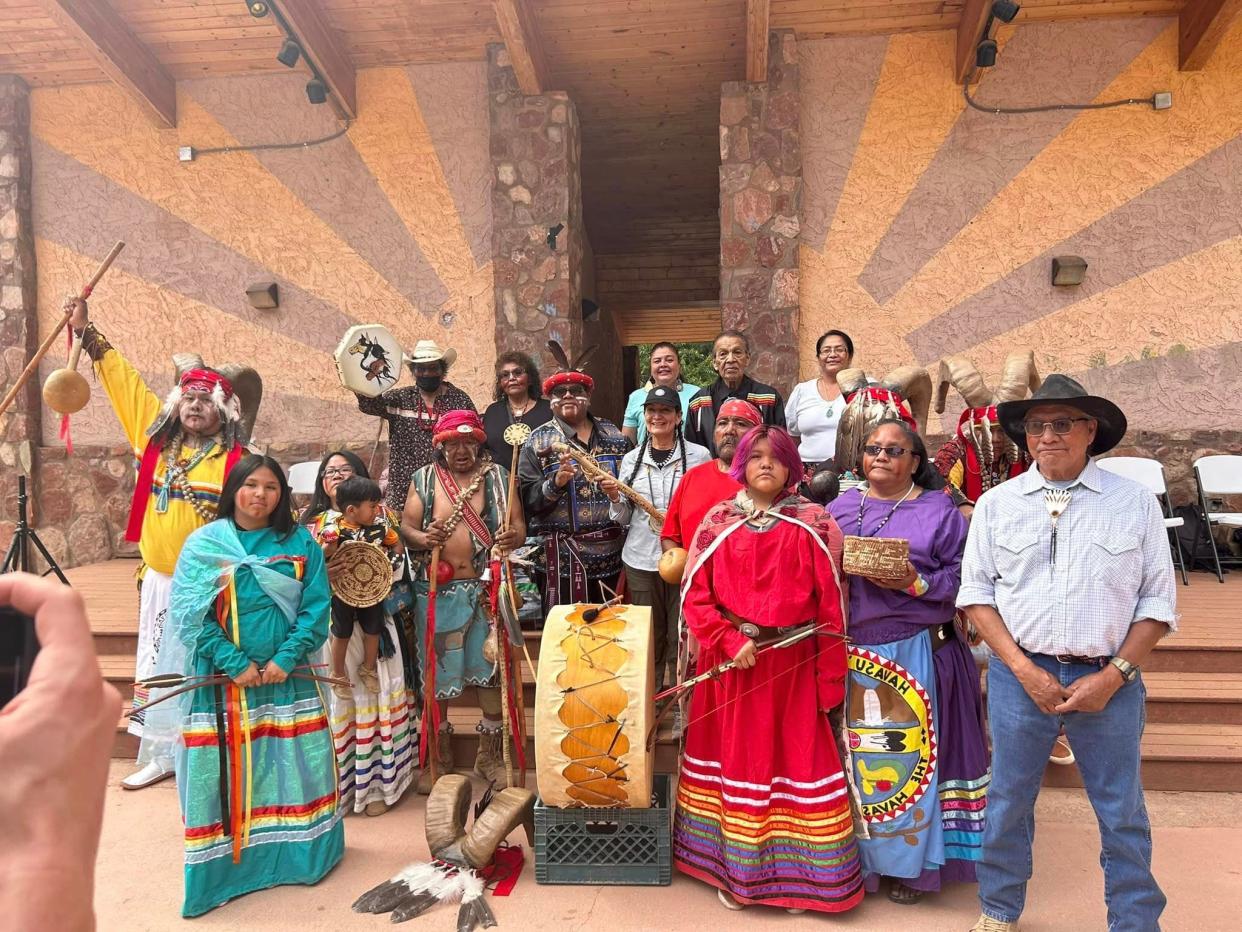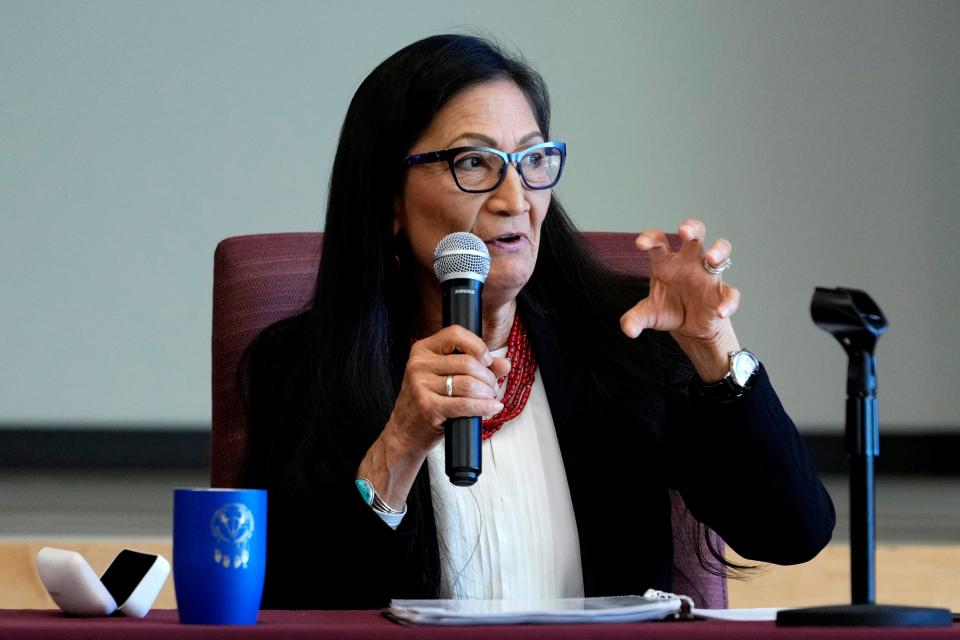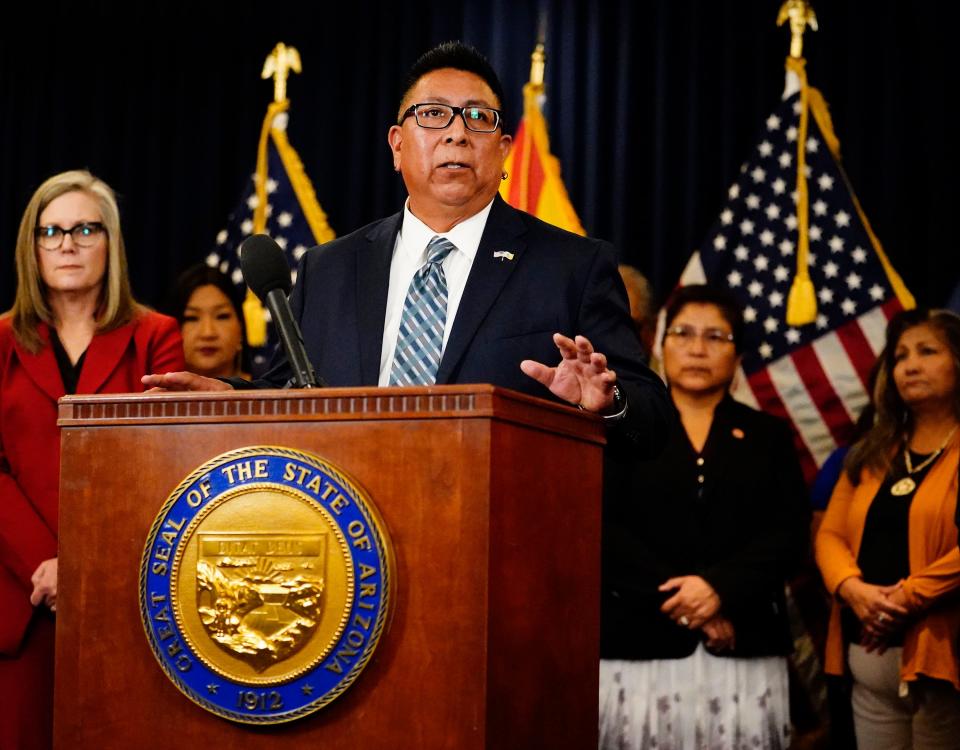Interior Secretary Deb Haaland talks with Arizona tribes at the Grand Canyon

Interior Secretary Deb Haaland paid unannounced visits to the Grand Canyon and several northern Arizona tribes over the weekend, ending with what the agency said was the first-ever visit of a sitting Interior Secretary to Supai in the Havasupai Tribe's lands on the Canyon's floor.
The visit's goal was to learn more about a proposed national monument advocated by tribes to protect lands around the Grand Canyon.
Haaland had accepted an invitation to the Canyon from Rep. Raúl Grijalva, D-Ariz. after an April 11 news conference hosted by him and Sen. Kyrsten Sinema, I-Ariz. where they and tribal leaders called on President Joe Biden to create a new national monument in the region where a mining ban currently exists.
The two lawmakers have tried and failed to pass legislation to enact stronger protections in the 1-million-acre region surrounding the Grand Canyon.
Mining protections: Tribes, lawmakers urge Biden to protect Grand Canyon region with a new national monument
Permanent protections sought for lands surrounding Grand Canyon
In 2012, then-Interior Secretary Ken Salazar issued a 20-year mining ban across more than 1 million acres of federal lands surrounding the Grand Canyon in a move to protect the region and the watershed from the potential adverse effects of additional mining of uranium and other ores.
The proposed Baaj Nwaavjo I’tah Kukveni Grand Canyon National Monument would include 1,102,501 acres of federal public land adjacent to Grand Canyon National Park in what is now the temporary mining ban area. It would enact permanent protections for cultural sites, watersheds and lands from destructive development while allowing land uses like grazing, wildlife management and recreation. It would also allow tribes to continue with cultural activities.

Baaj Nwaavjo means “where tribes roam” for the Havasupai Tribe and I’tah Kukveni means “our footprints” for the Hopi Tribe.
Even if the monument becomes reality, it won't prevent one currently permitted mine from going into production. The Pinyon Plain Mine has long been opposed by tribes and environmentalists, particularly the Havasupai Tribe, which fears its sole water supply will be contaminated, along with nearby sacred sites. The mine's operator disagrees, saying there are sufficient protections in place.
Amber Reimondo of the Grand Canyon Trust said a monument would prevent about 600 other mining claims from being pursued.
"Pressure from mines and congressional representatives who think this is some sort of linchpin in renewable energy has really ratcheted up the rhetoric," she said, citing a push to stop purchasing uranium from Russia. But the Grand Canyon area does not have optimum ore bodies, she said. Canada has high-grade uranium that's cheaper to purchase than to mine the lower-grade ores found in Northern Arizona, Reimondo said.
Navajo Nation President Buu Nygren told The Arizona Republic that he supports the idea of the national monument but wants it to be tribally co-managed, like Bears Ears National Monument. The Navajo Nation is part of the five-tribe coalition that co-manages the monument in southern Utah.
Natural resources: Interior Secretary Haaland tours Utah monuments at center of public lands debate
Haaland visits tribes, environmentalists to learn more
On Saturday, Haaland, Grijalva and staff from Sinema's office went to Grand Canyon Village to meet with tribal leaders and cultural practitioners, environmentalists, local officials and community members to learn more about the proposed monument.
She also heard from members of the Grand Canyon Tribal Coalition, a 12-tribe group that is pushing for the monument. A statement from the Interior Department said Haaland also visited the Canyon and saw the lands proposed for the monument. The meetings were not open to the public or to the media, and participants said they were advised to not advertise the visits in advance.
On Sunday, Haaland visited with the Hopi Tribe. She announced $6.6 million in funding from the Bipartisan Infrastructure Law to replace the water distribution system in Keams Canyon on the tribe's First Mesa.

On Monday, Haaland hiked down the 8-mile-long Havasupai Trail to Supai to visit with the continental U.S.'s most isolated tribe, the Havasupai. She met with the Havasupai Tribal Council and discussed the Biden administration's $2 billion allocation for tribal broadband services. In November, the tribe received a $7 million grant to upgrade its outdated and insufficient internet and telecommunications system to serve the community's 400 residents and tribal agencies.
Broadband services: In the Grand Canyon, the Havasupai Tribe prepares to build better connections to the world
Carletta Tilousi, a Havasupai elder and former council member, said several tribes traveled to Washington two weeks prior to again extend the invitation to the Interior secretary. The tribe dropped everything to prepare for Haaland's visit, she said.
"We've been ignored forever," Tilousi said, so they were especially excited for the visit.
Haaland hiked back up the steep switchbacks after the visit.
Tilousi is hopeful that Biden will use his presidential authority under the Antiquities Act to create the Baaj Nwaavjo I’tah Kukveni Grand Canyon National Monument.
"The Grand Canyon will be protected for future generations," she said.
The monument will also ensure that visitors, future generations of Indigenous peoples, wildlife and plants will be able to enjoy a clean Grand Canyon, Tilousi said. "That include waters that tribes have been fighting to protect."
Debra Krol reports on Indigenous communities at the confluence of climate, culture and commerce in Arizona and the Intermountain West. Reach Krol at debra.krol@azcentral.com. Follow her on Twitter at @debkrol.
Coverage of Indigenous issues at the intersection of climate, culture and commerce is supported by the Catena Foundation.
My articles are free to read, but your subscriptions support more such great reporting. Please consider subscribing today.
This article originally appeared on Arizona Republic: Deb Haaland visits Grand Canyon and Havasupai Tribe

